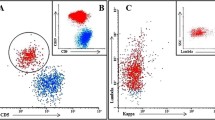Abstract
We reviewed 63 cases of cytologically confirmed leptomeningeal metastases (LM). 31 (49%) had solid tumors 17 (27%) had leukemia and 15 (24%) had lymphoma.
The most common presenting symptom was pain (76%) with radicular discomfort (58%), headache (32%), neck or back pain (17%). The predominant neurological signs were mental status abnormalities (49%), weakness (47%), seizures (14%).
The mode of presentation varied with tumor type. Patients with leukemia (18%) and lymphoma (13%) tended to present frequently with LM without systemic involvement, or during periods of apparent remission (leukemia 35%, lymphoma 27%), while patients with solid tumors had established systemic metastases (90%) at time of presentation. Laboratory studies did not vary among the groups. 71% had positive cytology on the first lumbar puncture (LP) and only 8% required more than 2 LPs. The cell count was a poor predictor of positive cytology as 29% of LP's with positive cytology and 36% of all LP's had less than 4 cells/mm.
We conclude that 1) LM presents with pain and seizures more frequently than has been previously recognized; 2) LM is frequently the mode of presentation in patients with leukemia and lymphoma and; 3) cytology is positive frequently in CSF specimens with normal cell counts and chemistries.
Similar content being viewed by others
References
Nugent JL, Bunn PA, Mathews MJet al.: CNS metastases in small cell bronchogenic carcinoma-increasing frequency and changing patterns with lengthening survivial. Cancer 44: 1885–1893, 1979
Yap HY, Yap BS, Tashima CK, DiStefano, Blumenschei GR: Meningeal carcinomatosis in breast cancer. Cancer 42: 283–286, 1978
Wasserstrom W, Glass P, Posner J: Diagnosis and treatment of leptomeningeal metastases from solid tumors. Cancer 49: 759–772, 1982
Olson M, Chernik N, Posner J: Infiltration of the leptomeninges by systemic cancer. A clinical and pathological study. Arch Neurol 30: 122–137, 1974
Little J, Dale A, Okazaki H: Meningeal carcinomatosis clinical manifestations. Arch Neurol 30: 138–143, 1974
Evans AE, Gilbert ES, Zandstra R: The increasing incidence of central nervous system leukemia in children. Cancer 26: 404–409, 1970
Jaeckle KA, Krol G, Posner JB: Evolution of computed tomographic abnormalities in leptomeningeal metastases. Ann. Neurology 17: 85–89, 1985
Kramer ED, Zimmerman RA, Packer R,et al.: Comparison of myelography with computed tomographic follow-up vs. Gadolinium magnetic resonance in aging for subarechnoid metastatic disease in children. Neurol 40: 243, 1990
Chamberlain MC, Sandy AD, Press GA: Leptomeningeal metastasis: a comparison of gadolinium — enhanced MR and contrast-enhanced CT of the brain. Neurol 40: 435–38, 1990
Author information
Authors and Affiliations
Rights and permissions
About this article
Cite this article
Kaplan, J.G., DeSouza, T.G., Farkash, A. et al. Leptomeningeal metastases: Comparison of clinical features and laboratory data of solid tumors, lymphomas and leukemias. J Neuro-Oncol 9, 225–229 (1990). https://doi.org/10.1007/BF02341153
Issue Date:
DOI: https://doi.org/10.1007/BF02341153




